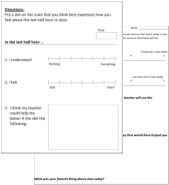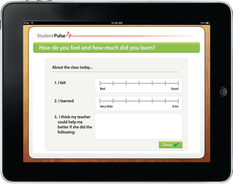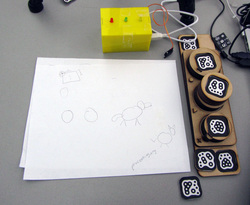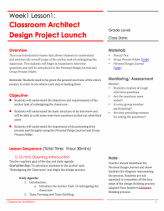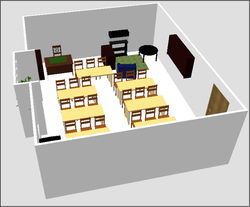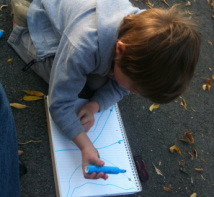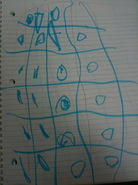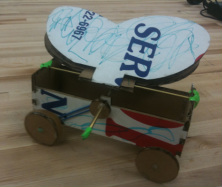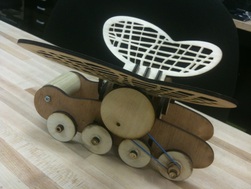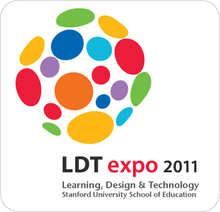Master's Project: Process Pad
Process Pad: Learning to Explain, Explaining to Learn
Team: Jain Kim, Colin Meltzer and Shima Salehi
We are interested in process, not just final answer. Process Pad is an interactive multitouch platform for capturing thought processes.
Click here to go to the Process Pad Website.
Team: Jain Kim, Colin Meltzer and Shima Salehi
We are interested in process, not just final answer. Process Pad is an interactive multitouch platform for capturing thought processes.
Click here to go to the Process Pad Website.
StudentPulse
CONCEPT PROTOTYPE
EDUC 338X, INNOVATION IN EDUCATION
Team: Caroline Damon, Philipp Herman, Sara Ittelson and Jain Kim
In a d.school class called "Innovations in Education", our 4-person design team tackled the issue of improving information and feedback flows from students to teachers.
Our team interviewed 8 teachers in depth and surveyed another 17 teachers to get a better understanding of the status quo, i.e. how do current feedback process look like, and the potential areas of improvements, i.e. what are unaddressed needs, preferences and pain points. We also interviewed and surveyed middle and high school students for similar empathy work.
We created a low-resolution prototype of in-class survey forms that we user-tested in one middle school and two high school classrooms.
Based on our findings, we proposed an in-the-moment feedback channel that motivates students to share their true thoughts and feelings as they experience them. StudentPulse is a mobile application where teachers can aggregate useful and actionable information straight from the students. Teachers can frame their own questions, at the time interval they want, either let the students be anonymous or not anonymous.
EDUC 338X, INNOVATION IN EDUCATION
Team: Caroline Damon, Philipp Herman, Sara Ittelson and Jain Kim
In a d.school class called "Innovations in Education", our 4-person design team tackled the issue of improving information and feedback flows from students to teachers.
Our team interviewed 8 teachers in depth and surveyed another 17 teachers to get a better understanding of the status quo, i.e. how do current feedback process look like, and the potential areas of improvements, i.e. what are unaddressed needs, preferences and pain points. We also interviewed and surveyed middle and high school students for similar empathy work.
We created a low-resolution prototype of in-class survey forms that we user-tested in one middle school and two high school classrooms.
Based on our findings, we proposed an in-the-moment feedback channel that motivates students to share their true thoughts and feelings as they experience them. StudentPulse is a mobile application where teachers can aggregate useful and actionable information straight from the students. Teachers can frame their own questions, at the time interval they want, either let the students be anonymous or not anonymous.
Play Pad
TANGIBLE PROTOTYPE
EDUC 211X, BEYOND BITS AND ATOMS – LAB
Team: Colin Meltzer and Jain Kim
Play Pad is a low-cost storytelling toolkit combining the tangible and digital worlds for creating stories, drawings and music with integrated sound recordings.
Play Pad is a precursor to Process Pad. It allows users to add sound recordings to specific points on a piece of paper. Play Pad is based on a computer vision technique, fiducial markers, to reference a physical location on a piece of paper to the digital location on a computer screen.
Click here for more info.
EDUC 211X, BEYOND BITS AND ATOMS – LAB
Team: Colin Meltzer and Jain Kim
Play Pad is a low-cost storytelling toolkit combining the tangible and digital worlds for creating stories, drawings and music with integrated sound recordings.
Play Pad is a precursor to Process Pad. It allows users to add sound recordings to specific points on a piece of paper. Play Pad is based on a computer vision technique, fiducial markers, to reference a physical location on a piece of paper to the digital location on a computer screen.
Click here for more info.
Classroom Architect
CURRICULUM
EDUC 208B, CURRICULUM CONSTRUCTION
Team: Colin Meltzer, Jain Kim, Pilar Wong and Swee Hong (David) Kwek
"Classroom Architect: Integrating Design Thinking and Math" is a project-based curriculum created for 5th grade Math class. Our team and the partnering teacher shared interest in applying design thinking to the school curriculum.
We used the principles of design thinking to review 5th grade standard Math concepts, such as measurement, scale and area. The focal task of this curriculum is for the students to create a 3-D virtual model of an ideal classroom, based on the data they collected as a group.
EDUC 208B, CURRICULUM CONSTRUCTION
Team: Colin Meltzer, Jain Kim, Pilar Wong and Swee Hong (David) Kwek
"Classroom Architect: Integrating Design Thinking and Math" is a project-based curriculum created for 5th grade Math class. Our team and the partnering teacher shared interest in applying design thinking to the school curriculum.
We used the principles of design thinking to review 5th grade standard Math concepts, such as measurement, scale and area. The focal task of this curriculum is for the students to create a 3-D virtual model of an ideal classroom, based on the data they collected as a group.
We are using a free interior design application called Sweet Home 3D (www.sweethome3d.com)
Butterfly Car
TANGIBLE PROTOTYPE
EDUC 211X, BEYOND BITS AND ATOMS – LAB
Team: Colin Meltzer and Jain Kim
The Dream Toy Project for Beyond Bits and Atoms class. Our client was a 4 year-old boy, whose dream toy was a "butterfly car with thousand of wheels and as big as the outer space."
The main challenge was to have the wings flap as the car moved forward. Our solution was to add lopsided wheels under the wings so that they would push the wings up and down as you pulled the car. We also made the wings interchangeable with another set of wings with different pattern. The final product was presented to our client.
Click here for more info.
EDUC 211X, BEYOND BITS AND ATOMS – LAB
Team: Colin Meltzer and Jain Kim
The Dream Toy Project for Beyond Bits and Atoms class. Our client was a 4 year-old boy, whose dream toy was a "butterfly car with thousand of wheels and as big as the outer space."
The main challenge was to have the wings flap as the car moved forward. Our solution was to add lopsided wheels under the wings so that they would push the wings up and down as you pulled the car. We also made the wings interchangeable with another set of wings with different pattern. The final product was presented to our client.
Click here for more info.
Etc.
LDT Expo 2011
Visualization for the expo of master's projects created by students in the Learning Design & Technology Master's Program in the School of Education at Stanford.
More at http://ldt.stanford.edu.
More at http://ldt.stanford.edu.
REDlab
Visualization for the REDlab (Research in Education and Design Lab) at Stanford University.
More at http://redlab.stanford.edu.
More at http://redlab.stanford.edu.


